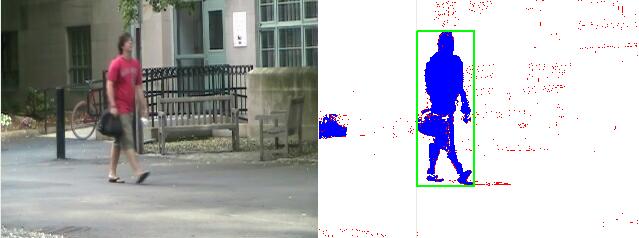Section: New Results
Background Subtraction
Participants : Vasanth Bathrinarayanan, Anh-Tuan Nghiem, Duc-Phu CHAU, François Brémond.
Keywords: Gaussian Mixture Model, Shadow removal, Parameter controller, Codebook model, Context based information
Statistical Background Subtraction for Video Surveillance Platform
Anh-Tuan Nghiem work on background subtraction is an extended version of Gaussian Mixture Models [73] . The algorithm compares each pixel of current frame to background representation which is developed based on the pixel information from previous frames. It includes shadow and highlight removal to give better results. Selective background updating method based on the feedback from the object detection helps to better model background and remove noise and ghosts.
Figure 10 shows a sample illustration of the output of the background subtraction, where blue are foreground pixels and red are shadow or illumination change pixels and a green bounding box is a foreground blob. Also we have compared our algorithm with few other such as OpenCV and also IDIAP's background subtraction(not tuned perfectly, used default parameters) and the results are shown in Figure 11 where the green background refers to best performance of the comparisons. This evaluation is done on PETS 2009 data-set with our obtained foreground blobs to the manually annotated bounding boxes of people.
Parameter controller using Contextual features
The above method has some parameters that has to be tuned every time for each video, which is a time consuming work. The work of Chau et al [59] learns the contextual information from the video and controls object tracking algorithm parameters during the run-time of the algorithm. This approach is at preliminary stage for background subtraction algorithm to automatically adapt parameters. These parameters are learned as described in the offline learning process block diagram 12 over several ground truth videos and clustered into a database. The contextual feature which are used presently include object density, occlusion, contrast, 2D area, contrast variance, 2D area variance. Figure 13 shows a sample of video chunks based on contextual feature similarity for a video from caviar data-set.
The controller's preliminary results are promising and we are experimenting and evaluating with different features to learn the parameters. The results will be published in upcoming top computer vision conferences.






